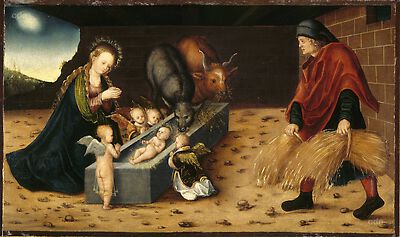Catalogue Information: The work, perfunctory in execution and of studio or copy quality though it – and even its original – is, was vested with the spurious imprimatur of the then authorities on Cranach for its authenticity by Agnew's, who falsely claimed for it the identity of the picture last recorded with Dr. Weber in Halle in 1932, despite the evidence of their own eyes, that it could not have been the same picture. It was nonetheless chosen by Agnew's to represent Sir John Heathcoat-Amory's crucial importance to the firm as a client in the doldrums of dealing after the Second World War. Lady Heathcoat-Amory, who had shared her husband's pleasure in collecting, was unable to understand why this picture was chosen, in preference to the 'Holbein', the 'Rembrandt', the 'Claude', the 'Turner', or one of the 'Constables': the National Trust had felt it kinder (knowing that the Agnew family had been friends and guests of Sir John and Lady Heathcoat-Amory) not to disabuse her of her belief in the authenticity of those pictures. [...]
Exhibs: [Supposedly, but not - that was Dr. Weber's picture - Kaiser-Friedrich-Museum, Berlin, Gemälde alter Meister, 1925, No.84]; Fermoy Art Gallery, King's Lynn, Heathcoat-Amory Collection, 1965, no.3; Sir Geoffrey Agnew (1908-1986), Dealer and Connoisseur, Thos. Agnew & Sons Ltd, 1988, no.7 (as by Cranach himself, of c.1520, citing the 1978 revision of Max [called by them 'W'] Friedländer and Jakob Rosenberg's catalogue entry, as if it referred to the present painting). [...]
The painting is not even alluded to in either [Schade 1974]; nor in Dieter Koepplin & Tilman Falk's exhibition catalogue, [Exhib. Cat. Basel 1974]; neither of which, however, also aspires to the status of a catalogue of the painter's known works; nor is the picture cited as either with Agnew's or as in the Heathcoat-Amory collection at Knightshayes by Jakob Rosenberg, in his 1978 revision of [Friedländer, Rosenberg 1932], published as The Paintings of Lucas Cranach, London, 1978. This does, however, both include and illustrate the Burlet/Weber picture, as its cat. no.103, p.90 & pl.103, which appears to be of a quite distinct, and more richly painted, thing. Not only is the configuration of the stones and pebbles on the ground quite different, but Joseph wears a dark, not a light-coloured, cloak, and has boots that do not stop at the ankles, but disappear into his skirt. Even of the Weber picture, however, he says of it and of an Adoration of the Magi with Steinmeyer in Paris in 1909, which had been adduced as a comparison in 1932: 'Both may be no more than competent workshop productions'.
(Text by former NT Curator of Pictures & Sculpture, Alastair Laing, copied from NT file)
[National Trust, revised 2017]
